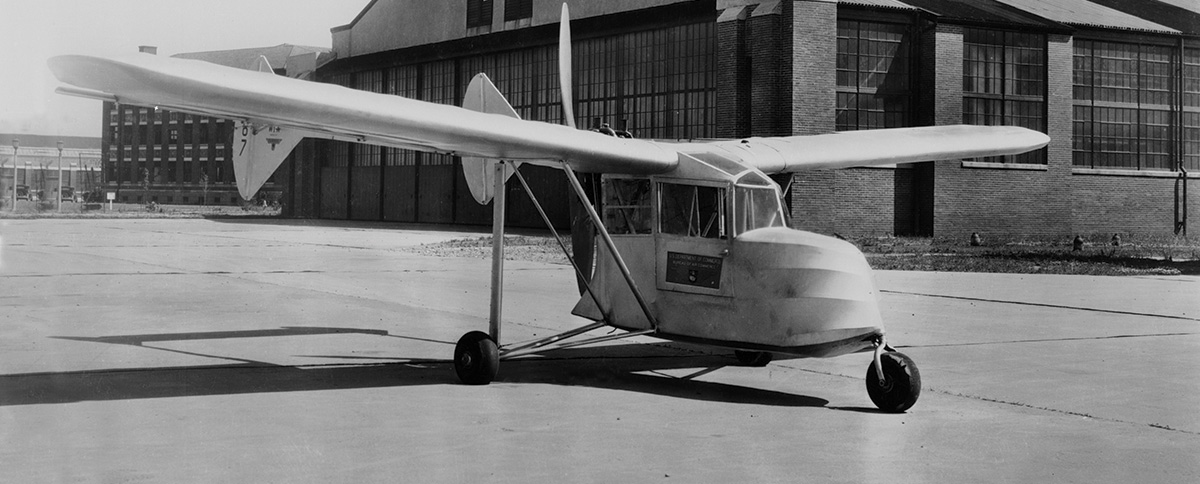In his quest to build the world’s safest airplane, the designer pioneered several familiar features on an unfamiliar prototype.
Of the many pioneers in the history of aircraft design, Fred Weick may not be immediately familiar to most aviation enthusiasts. But for anyone involved in general aviation, he should be. Weick made major contributions to aircraft design before he even built his first airplane. The aircraft that he eventually did design were supremely successful, built in large numbers, and many of them are still flying today.
Born in Berwyn, Ill., in 1899, Fred Ernest Weick graduated with an engineering degree from the University of Illinois in 1922 and turned his attention to aviation. Employed by the U.S. Airmail Service as a pilot, he helped establish a system of emergency landing fields for use by mailplanes. In 1925 he went to work for the National Advisory Committee on Aeronautics (NACA, the predecessor of NASA) at Langley, Va. There he helped design propellers as well as the facility’s full-sized wind tunnel. He also designed the famous NACA cowling, which enabled efficient, low-drag installation of air-cooled radial engines that were aerodynamically competitive with heavier and more complicated, but lower-drag, liquid-cooled power plants.
Weick’s greatest interest, however, was in the development of safe, efficient and inexpensive aircraft for the general aviation market. He sought to produce an airplane that could take the place of the family car, a sort of “flying Model T.” To that end he designed the W-1 to serve as a testbed for a number of novel features that he had in mind.
The W-1 incorporated innovations in four areas. The first, Weick said, was a tricycle landing gear arrangement, “to eliminate many of the present landing, take-off and ground handling difficulties.” Then there were “means of obtaining positive lateral stability and control at low speed without danger of stalling.” Third was “the inclusion of flap arrangements for positive control of the glide path at steep angles in order for the pilot to land in the exact spot intended.” The fourth innovation was “a means of combining the rudder and aileron controls into a single control in order to simplify the control system from three elements to only two, particularly under adverse conditions such as those of precision landings in a cross-wind.” Weick believed that combining the rudder and aileron controls would also prevent the pilot from accidentally crossing the controls, causing the aircraft to stall and enter a spin.
Constructed in a garage in his spare time with the help of a few of his Langley colleagues, Weick’s W-1 was a unique-looking aircraft when first flown in 1934, and it still looks unusual today. It was a high-wing, single-engine, twin-boom pusher monoplane with twin fins and rudders. The enclosed two-seat cockpit was situated forward of the wing, where the occupants enjoyed an excellent field of view. Its tricycle landing gear incorporated a steerable nose wheel—a very unusual feature at that time. In fact, the W-1 was one of the first airplanes to include steerable tricycle gear.
As originally built, the wing had conventional ailerons and large auxiliary airfoils mounted ahead and above the leading edge, forming a sort of slot. A later version, the W-1A, featured a different wing without the leading-edge airfoils, but with large trailing-edge flaps and unusual slotted ailerons mounted at mid-chord.
Powered by a British 85-hp Pobjoy Niagara air-cooled radial, the W-1 had a top speed of 110 mph and cruised at 80 mph. It demonstrated good stability and control, and, according to Weick, was “automatically non-spinning.” The aircraft also exhibited excellent short takeoff and landing characteristics. Wieck said that it could clear a 50-foot obstacle after only a 200-foot takeoff roll.
Impressed with Weick’s airplane, the Department of Commerce bought it from him for further research. It was reportedly damaged in 1936 after crash-landing in a schoolyard due to engine failure. By that time Weick had moved on to a job at the Engineering and Research Corporation of Riverdale, Md., for whom he designed a small two-seater based upon the lessons he had learned from the W-1. First flown in 1938, the new airplane still featured a twin tail, steerable tricycle landing gear and combined aileron and rudder controls. This time, however, those features appeared on a more attractive low-wing tractor monoplane. Marketed as the ERCO Ercoupe, “the world’s safest airplane,” it was a huge success, with 5,685 produced between 1937 and 1969.
In 1948 Weick joined the engineering faculty at Texas A&M University. While there he designed and built the AG-1, the world’s first specialized agricultural airplane (previous crop dusters had been modified from aircraft designed for other purposes). Although only one prototype was built, after becoming director and chief engineer for Piper in 1957, Weick incorporated the AG-1’s innovations into the highly successful PA-25 Pawnee agricultural plane, 5,167 of which were built between 1959 and 1981. Weick also co-designed an economical, all-metal, four-place cabin monoplane for Piper, the PA-28 Cherokee. Since its introduction in 1960, more than 32,000 Cherokees have been manufactured.
After retiring from Piper in 1970, Weick remained an active participant in the annual Experimental Aircraft Association airshow at Oshkosh, Wisc., until his death from heart disease on July 8, 1993. Perhaps one reason why his name is not as familiar as those of other aeronautical pioneers is that Weick was more concerned with flight safety than with speed, size or military potential. Another reason may be that none of the aircraft he designed actually bore his name…apart from the very first one.
This feature originally appeared in the November 2017 issue of Aviation History Magazine. Subscribe today!

